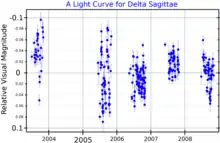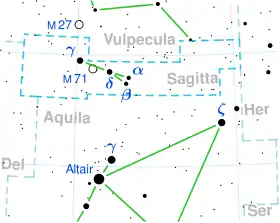Delta Sagittae
Delta Sagittae (Delta Sge, δ Sagittae, δ Sge) is a binary star in the constellation of Sagitta, with an apparent magnitude of +3.68. The primary component is a red M-type bright giant, and the secondary is a B-type main-sequence star.[2] It is approximately 430 light years from Earth, based on its Gaia Data Release 2 parallax.[1]

Delta Sagittae is a spectroscopic binary with a composite spectrum, meaning that light from both stars can be detected. It has an orbital period of about 10 years and an eccentricity of about 0.44.[4] It is also a variable star, with its brightness changing between a maximum of magnitude 3.75 and a minimum of 3.83 in an unpredictable way.[6]
Delta Sagittae is moving through the Galaxy at a speed of 9.8 km/s relative to the Sun. Its projected Galactic orbit carries it between 23,800 and 35,300 light years from the center of the Galaxy.[13]
Naming
In Chinese, 左旗 (Zuǒ Qí), meaning Left Flag, refers to an asterism consisting of δ Sagittae, α Sagittae, β Sagittae, ζ Sagittae, γ Sagittae, 13 Sagittae, 11 Sagittae, 14 Sagittae and ρ Aquilae. Consequently, the Chinese name for δ Sagittae itself is 左旗三 (Zuǒ Qí sān, English: the Third Star of Left Flag.)[14]
References
- Brown, A. G. A.; et al. (Gaia collaboration) (August 2018). "Gaia Data Release 2: Summary of the contents and survey properties". Astronomy & Astrophysics. 616. A1. arXiv:1804.09365. Bibcode:2018A&A...616A...1G. doi:10.1051/0004-6361/201833051. Gaia DR2 record for this source at VizieR.
- "* del Sge". SIMBAD. Centre de données astronomiques de Strasbourg. Retrieved 23 February 2017.
- Calculated from subtracting magnitudes.
- Eaton, Joel A.; Hartkopf, William I.; McAlister, Harold A.; Mason, Brian D. (1995). "Winds and accretion in delta Sagittae". Astronomical Journal. 109 (4): 1856–1866. Bibcode:1995AJ....109.1856E. doi:10.1086/117412.
- Mermilliod, J.-C. (1986). "Compilation of Eggen's UBV data, transformed to UBV (unpublished)". Catalogue of Eggen's UBV Data. Bibcode:1986EgUBV........0M.
- Samus, N. N.; Durlevich, O. V.; et al. (2009). "VizieR Online Data Catalog: General Catalogue of Variable Stars (Samus+ 2007-2013)". VizieR On-line Data Catalog: B/GCVS. Originally Published in: 2009yCat....102025S. 1: B/gcvs. Bibcode:2009yCat....102025S.
- Wilson, Ralph Elmer (1953). "General catalogue of stellar radial velocities". Carnegie Institute Washington D.C. Publication. Bibcode:1953GCRV..C......0W.
- Brown, A. G. A.; et al. (Gaia collaboration) (2021). "Gaia Early Data Release 3: Summary of the contents and survey properties". Astronomy & Astrophysics. 649: A1. arXiv:2012.01533. Bibcode:2021A&A...649A...1G. doi:10.1051/0004-6361/202039657. S2CID 227254300. (Erratum: doi:10.1051/0004-6361/202039657e). Gaia EDR3 record for this source at VizieR.
- Anderson, E.; Francis, Ch. (2012), "XHIP: An extended hipparcos compilation", Astronomy Letters, 38 (5): 331, arXiv:1108.4971, Bibcode:2012AstL...38..331A, doi:10.1134/S1063773712050015, S2CID 119257644.
- Schröder, K.-P.; Cuntz, M. (2007). "A critical test of empirical mass loss formulas applied to individual giants and supergiants". Astronomy and Astrophysics. 465 (2): 593–601. arXiv:astro-ph/0702172. Bibcode:2007A&A...465..593S. doi:10.1051/0004-6361:20066633. S2CID 55901104.
- Messineo, M.; Brown, A. G. A. (2019). "A Catalog of Known Galactic K-M Stars of Class I Candidate Red Supergiants in Gaia DR2". The Astronomical Journal. 158 (1): 20. arXiv:1905.03744. Bibcode:2019AJ....158...20M. doi:10.3847/1538-3881/ab1cbd. S2CID 148571616.
- Tabur, V.; Bedding, T. R.; Kiss, L. L.; Moon, T. T.; Szeidl, B.; Kjeldsen, H. (December 2009). "Long-term photometry and periods for 261 nearby pulsating M giants". Monthly Notices of the Royal Astronomical Society. 400 (4): 1945–1961. arXiv:0908.3228. Bibcode:2009MNRAS.400.1945T. doi:10.1111/j.1365-2966.2009.15588.x. S2CID 15358380.
- "Delta Sagittae (HIP 97365)". Archived from the original on 2013-01-02. Retrieved 2012-09-17.
- (in Chinese) AEEA (Activities of Exhibition and Education in Astronomy) 天文教育資訊網 2006 年 7 月 3 日
